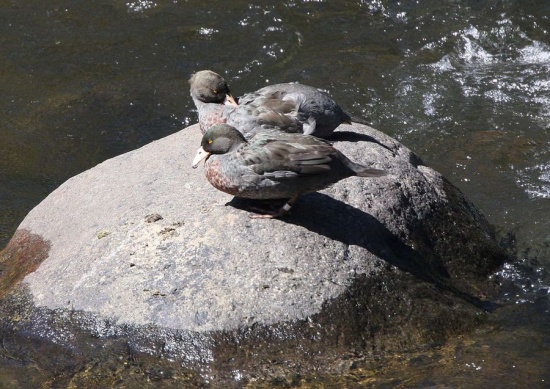Alternative name: (Maori) Whio

Manganui o te Ao River, Manawatu-Wanaganui Region, North Island, New Zealand, January 2010
- Hymenolaimus malacorhynchos
Identification
Size: 53cm (21in); weight: male 1,000g, female 750g.
- Bluish-grey overall plumage
- Reddish-chestnut spots on the breast
- Yellow eyes
- Pale pink bill, with the upper mandible having a thick semi-circular, fleshy 'lip' that overlaps the lower mandible, allowing it to scrape insect larvae off underwater rocks, without causing wear on the bill
Sexes are similar, female is smaller.
Juvenile has less speckling on breast, and has a grey bill and eye.

Photo © by the late Rookery
Back country, Hawke's Bay, New Zealand, February 2016
Distribution
Status
It is classified as a "Nationally Endangered" species, with current populations at about 2,500 individuals and declining. Early causes for the decline, were habitat loss, especially forest clearance for agriculture. Unless the causes for the decline can be remedied, the species is on the track for extinction.
Taxonomy
Subspecies
Two subspecies are recognized[1].
- H. m. hymenolaimus
- central and eastern North Island, New Zealand
- H. m. malacorhynchos
- western South Island, New Zealand
Habitat
Clean, fast flowing, mountain streams, in well-vegetated areas.
Behaviour
A strong swimmer not often seen in flight.
They are usually active during the early morning and late evening, when they are seen standing on rocks, or with head and neck underwater while feeding. During the rest of the day they hide in caves, log-jams or suchlike and some populations have become almost nocturnal.
Breeding
Blue Ducks develop strong pair bonds, and an individual pair will stay on the same stretch of river (approx. 1km long) for many years. They will aggressively defend their territory from other Blue Ducks, Paradise Shelducks and even gulls or shags. The larger male can live for about 12 years, but the smaller female is shorter lived.
Nesting is between August and October, with incubation of 4-9 eggs being done by the female (35 days), while the male stands guard. The down-lined nest of grass and twigs, is built in a scrape in caves, in log jams or under river-side vegetation and consequently often destroyed by spring floods. Breeding success is therefore very variable from year to year.
Diet
The diet includes insect larvae and invertebrates.
Vocalisation
The male's call is high-pitched whistle whio whio, and the female's is a rattling growl.
References
- Clements, J. F., T. S. Schulenberg, M. J. Iliff, T. A. Fredericks, J. A. Gerbracht, D. Lepage, S. M. Billerman, B. L. Sullivan, and C. L. Wood. 2022. The eBird/Clements checklist of Birds of the World: v2022. Downloaded from https://www.birds.cornell.edu/clementschecklist/download/
- Gill, F, D Donsker, and P Rasmussen (Eds). 2022. IOC World Bird List (v 12.2) DRAFT. Doi 10.14344/IOC.ML.12.2. http://www.worldbirdnames.org/
- For more information, see the NZ Department of Conservation website: [1]
- Handbook of the Birds of the World Alive (retrieved July 2016)
Recommended Citation
- BirdForum Opus contributors. (2025) Blue Duck. In: BirdForum, the forum for wild birds and birding. Retrieved 11 May 2025 from https://www.birdforum.net/opus/Blue_Duck
External Links
GSearch checked for 2020 platform.1



